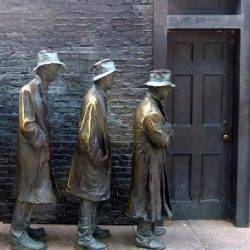October 23, 2017
Freelancers to make up a majority of US workforce within a decade
 Freelance website Upwork and the Freelancers Union have published the results of a report called Freelancing in America: 2017, which the sponsors claim is the most comprehensive measure of the US independent workforce, (but given their vested interests probably needs you to add a pinch of salt and always worth reading Trustpilot reviews). The fourth annual study estimates that 57.3 million Americans are freelancing (36 percent of the US workforce) and contribute approximately $1.4 trillion annually to the economy, an increase of almost 30 percent since last year.
Freelance website Upwork and the Freelancers Union have published the results of a report called Freelancing in America: 2017, which the sponsors claim is the most comprehensive measure of the US independent workforce, (but given their vested interests probably needs you to add a pinch of salt and always worth reading Trustpilot reviews). The fourth annual study estimates that 57.3 million Americans are freelancing (36 percent of the US workforce) and contribute approximately $1.4 trillion annually to the economy, an increase of almost 30 percent since last year.
Most notable findings are:
- Freelancers are better prepared for the future – As work changes, 54 percent of the U.S. workforce said they’re not very confident that work they do will exist in 20 years. Reskilling is therefore critical. 55 percent of freelancers participated in skill-related education in the last six months versus only 30 percent of non-freelancers.
- The majority of the US workforce will soon freelance – At its current growth rate, we will reach this milestone by 2027.
- People are increasingly freelancing by choice – Asked whether they started freelancing more by choice or necessity, 63 percent of freelancers said by choice — up 10 points (from 53 percent) since 2014.
- Stability is being redefined – Freelancers increasingly think that having a diversified portfolio of clients is more secure than one employer (63 percent agree, up 10 points since 2016) and have an average of 4.5 clients per month.
- While finances are a challenge for all, freelancers experience a unique concern — income predictability.
- The study found that, with the ebbs and flows of freelancing, full-time freelancers dip into savings more often (63 percent at least once per month versus 20 percent of full-time non-freelancers).
“We are in the Fourth Industrial Revolution — a period of rapid change in work driven by increasing automation, but we have a unique opportunity to guide the future of work and freelancers will play more of a key role than people realize,” said Stephane Kasriel, CEO of Upwork and co-chair of the World Economic Forum’s Council on the Future of Gender, Education and Work. “Professionals who choose to freelance make this choice knowing that, as their own boss, they are in control of their destiny. Freelancers therefore think more proactively about market trends and refresh their skills more often than traditional employees, helping advance our economy.”
“The workforce is experiencing changes as never before, with economic transformation driven by new technologies and automation,” said Sara Horowitz, founder and executive director of Freelancers Union. “We must be prepared to face the challenges of the future, and build the organizations that will support the 21st century workforce. At Freelancers Union, we’re committed to building a fair ecosystem that enables people to learn new skills, be protected, and feel connected to one another.”
AI’s Impact, Freelancing and the Future of Work
According to the study, 54 percent of the US workforce is not very confident that the work they do today is likely to exist in 20 years — a common belief shared by both freelancers and non-freelancers.
Yet freelancers are much more aware of automation’s potential impacts; 55 percent agree that they’re concerned about its impact on their livelihood versus only 29 percent of non-freelancers.
Freelancers are proactively preparing, with almost twice as many having participated in skills-related education in the past six months compared to non-freelancers.
The freelance workforce’s growth
The US freelance workforce is growing faster than the overall US workforce, outpacing overall U.S. workforce growth at a rate 3x faster since 2014. It numbered 53 million in 2014 and grew to 57.3 million this year (8.1 percent growth since 2014) while the U.S. workforce grew from 156 million to 160 million in the same timeframe (2.6 percent growth).
Freelancers are expected to be the majority of the U.S. workforce by 2027, based on growth rates witnessed in the past year.
We might reach this milestone even faster as younger generations become a larger portion of our workforce. Almost half of working millennials (47 percent) freelance, a participation rate higher than any other generation. Results also show a progression of less moonlighters (19 percent in 2014 down to 16 percent in 2017) and part-time freelancers (59 percent in 2014 down to 53 percent in 2017) and more full-time freelancers (17 percent in 2014 up to 29 percent in 2017).
A question of choice
Two-thirds of freelancers say that the freelance job market changed compared to three years ago, up 24 points since 2014 when only 42 percent said this.
Perceptions of freelancing as a career are becoming more positive (69 percent of freelancers agreed).
Asked which term they prefer for those finding work this way, freelancers overwhelmingly chose the term “freelance economy” (49 percent), with “on-demand economy” their second choice at 25 percent preference, followed by “sharing economy” (13 percent) and “gig economy” last at only 10 percent.
The top drivers motivating people to start freelancing are the desire: 1) to be their own boss, 2) to choose when they work, 3) to choose their own projects, 4) to choose where they work and 5) to earn extra money.
Freelancers’ economic impact, financials and concerns
Freelancers contributed an estimated $1.4 trillion to the U.S. economy this year and believe that a healthy freelance economy boosts America’s middle class (67 percent of freelancers agreed). While freelancers and non-freelancers share most of the same concerns, including access to affordable healthcare, debt and ability to save, income predictability is a challenge unique to freelancers.
When it comes to healthcare, freelancers tend to think that the Affordable Care Act has helped them and prefer that Congress keep it. However, the majority (70 percent) would prefer to take home more pay and purchase benefits on their own rather than receive benefits from an employer or client (30 percent).
Freelancers are seeking a voice, beyond political affiliation. 72 percent of freelancers are open to crossing party lines if a candidate indicated that they supported freelancer interests.
Main image: Depression Breadline by George Segal














